Rotational Rest Frequencies and First Astronomical Search of Protonated Methylamine
- 1I. Physikalisches Institut, Universität zu Köln, Köln, Germany
- 2Max Planck Institute for Extraterrestrial Physics, Garching bei München, Germany
We report first laboratory rest frequencies for rotational transitions of protonated methylamine,
1 Introduction
The cyano radical, CN, was one of the first molecules detected in the interstellar medium (McKellar, 1940). It is astrochemically linked to its hydrogenated and protonated forms, most of which have been detected in the interstellar medium, typically in the galactic center source Sgr B2, such as HCN (Snyder and Buhl, 1971), HNC (Snyder and Buhl, 1972; Zuckerman et al., 1972), HCNH+ (Ziurys and Turner, 1986), and H2C = NH (Godfrey et al., 1973). The terminal product of this hydrogenation series is methylamine, CH3NH2, which has been well characterized by laboratory spectroscopy (Ohashi et al., 1987; Ilyushin and Lovas, 2007; Motiyenko et al., 2014) and was first detetcted in Sgr B2 and Orion A in 1974 by Kaifu et al. (1974) and Fourikis et al. (1974).
In interstellar environments, molecules may also occur in their protonated forms, generated by a proton transfer from a proton donor like
Following up on our recent work on the high-resolution rotational spectra of CN+ (Thorwirth et al., 2019a) and
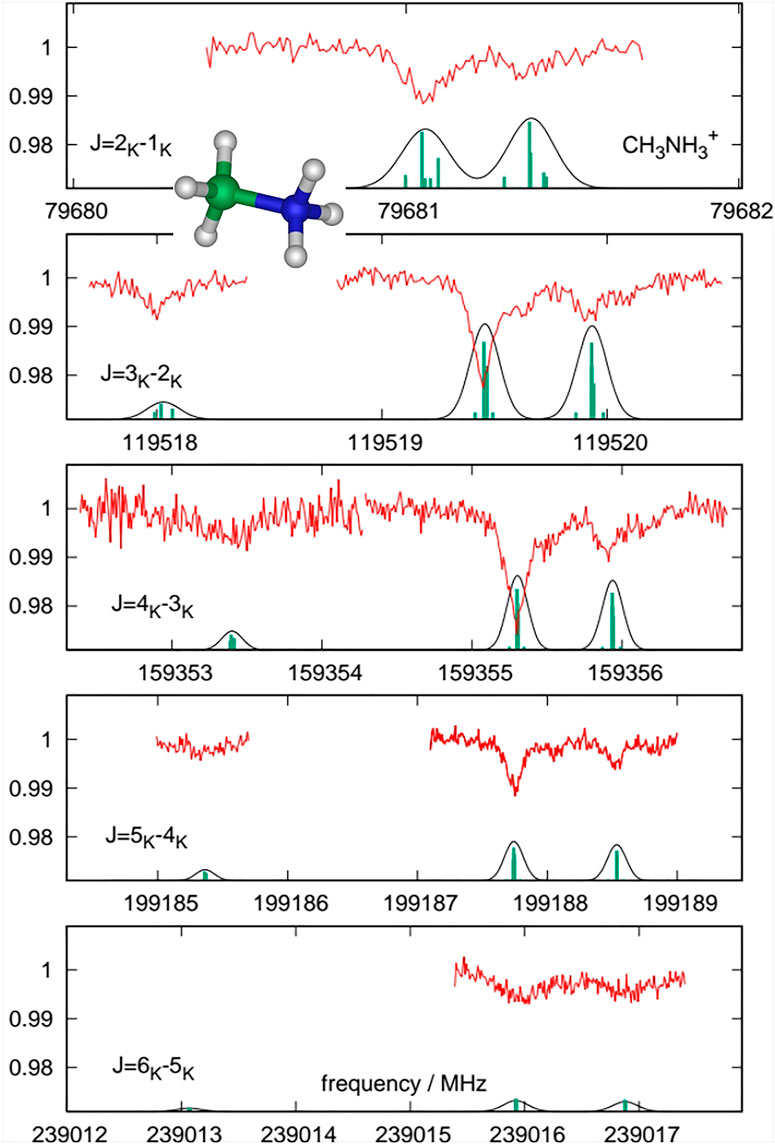
FIGURE 1. Measurements of the
2 Experimental Methods
The rotational transitions of
3 Computational Methods
As no previous high-resolution experimental data were available for
All calculations were performed using the CFOUR program (Matthews et al., 2020) and strategies summarized elsewhere (Puzzarini et al., 2010). The computed spectroscopic parameters are listed in Table 1 that also provides scaled (best-estimate) parameters obtained from a comparison of experimental and calculated values of isoelectronic ethane, C2H6 (see, e.g., Martinez et al. (2013) for a similar procedure used in the vinyl acetylene/protonated vinyl cyanide family of isoelectronic species). Additional results from the calculations are given in the Supplementary Material. An estimate of the torsional barrier height was obtained using the energy difference between the staggered and the eclipsed forms of

TABLE 1. Calculated and experimental spectroscopic parameters (in MHz, unless noted otherwise) of
4 Laboratory Results and Spectroscopic Parameters
Using frequency predictions based on the new high-level quantum-chemical calculations, the lines shown in Figure 1 were found subsequently during targeted spectroscopic survey scans. The spectra were recorded in individual measurements in which the frequency was stepped in an up-and-down manner several times. The frequency steps were typically 2 kHz, except for the JK = 4K ← 3K measurement at 159 GHz, for which 10 kHz steps were applied. Such individual measurements were repeated typically ten times. In the depiction of Figure 1, all available spectra were accumulated and rebinned to a stepwidth of 10 kHz. This deep integration was necessary due to the comparably small signal strength (maximum depletion upon photon absorption is on the order of 2%), and due to somewhat noisy signal counts, which had its origin in ion source instabilities caused by the sticky consistency of the methylamine precursor. Also, during the measurements, care was taken to avoid power broadening. Thus, the linewidths were expected to be dominated by the Doppler broadening due to the kinetic temperature of the ions in the trap (nominal temperature T = 4 K with some residual heating to typically 8 K), and a possible contribution due to non-resolved hyperfine splitting. The line patterns detected for a given rotational transition were in line with those expected for a prolate symmetric top molecule and at first sight, no further spectroscopic complexity, as could be expected for resolved nitrogen quadrupole hyperfine structure or torsional motion between the CH3 and NH3 subunits, was detected in individual measurements at our experimental conditions. For all individual measurements, the detected lines were fitted to Gaussian functions, from which line centers and their uncertainties were determined, and the first results were very similar to the frequencies quoted in Table 2 (Model I).
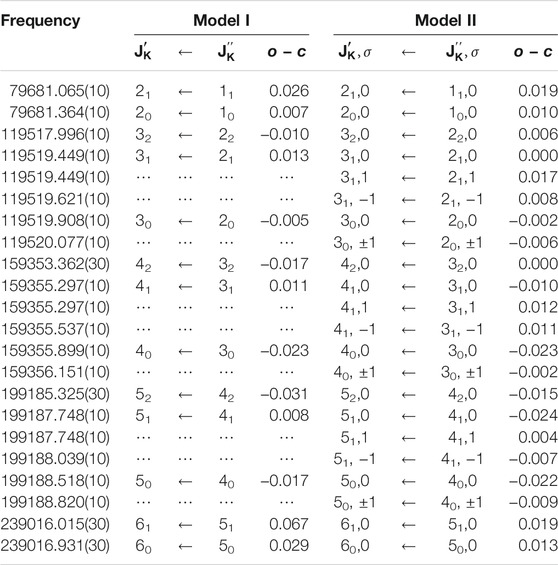
TABLE 2. Frequencies of pure rotational transitions (in MHz) of
The measured frequencies of the pure rotational lines collected in Table 2 (Model I) were first fit with a standard symmetric rotor Hamiltonian using the PGOPHER program (Western, 2017), yielding the set of parameters for the ground state given in Table 1 (fit I). Since the transitions of a symmetric rotor obey the ΔK = 0 selection rule, A and DK cannot be determined experimentally, and only B0, DJ and DJK were derived in the least-squares fitting procedure and are presented in Table 1. Computed parameters are also included in Table 1 for comparison. As can be seen, the overall agreement between the calculated and scaled best-estimate values and the experimental values is very good. A simulated stick spectrum and its convolution, based on fit I of Table 1 and accounting for the hyperfine structure due to the quadrupole moment of the
Closer inspection after co-addition of all spectra revealed some noticeable blue-shifted shoulders, as discernible in the accumulation of Figure 1. These are particularly evident in the spectra at 119 (J = 3K − 2K) and 159 GHz (J = 4K − 3K), but are also discernible in the weaker spectrum at 199 GHz (J = 5K − 4K). In the spectrum at 119 GHz (second panel in Figure 1 and close-up in Figure 2) both blue shoulders have an offset of about +170 kHz relative to the main peaks (K = 0 and 1), and this offset is found to increase for the higher frequency transitions at 159 (
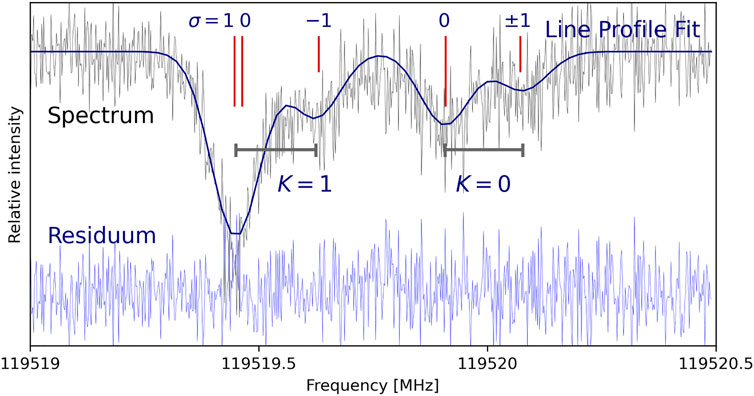
FIGURE 2. Zoom into the transition 3K ← 2K (K = 0, 1) highlighting internal rotation splitting in
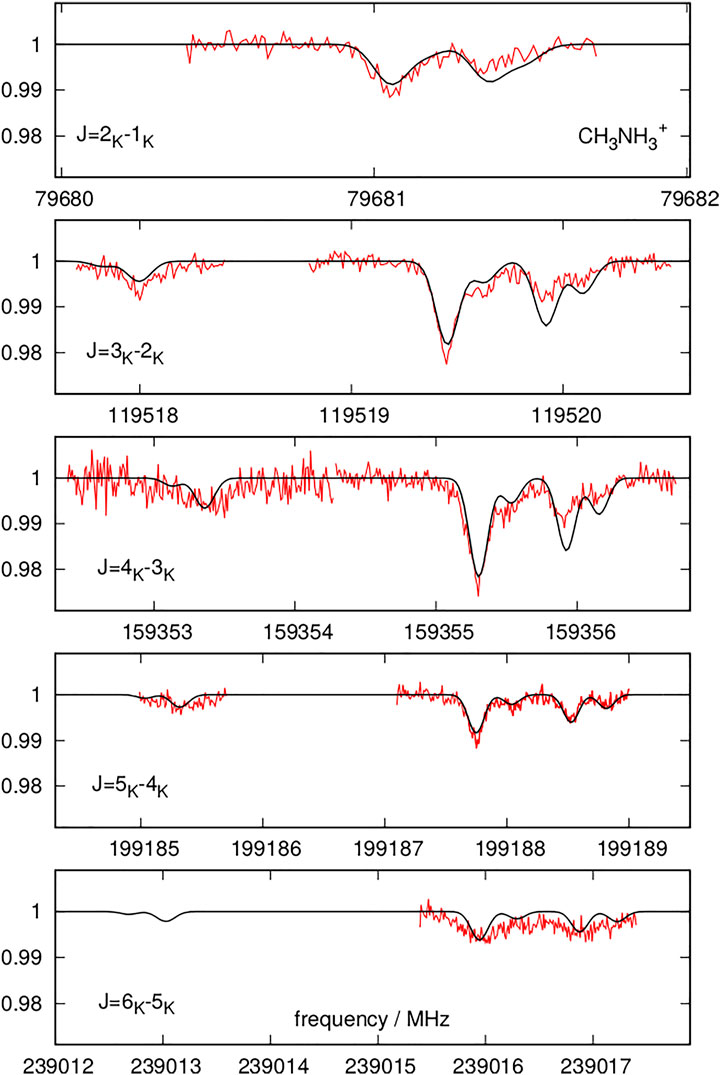
FIGURE 3. Same as Figure 1 but with torsional splitting included into the simulation (black line, Table 1, fit II). Owing to the very small magnitude of eQq(14N) calculated here, quadrupole hyperfine structure has not been considered in this simulation.
5 Interstellar Search
The
The detection of species closely related to protonated methylamine such as HCN, HCNH+ or CH3NH2 in the star-forming region Sgr B2 (e.g., Schilke et al., 1991; Belloche et al., 2013) motivates the search for protonated methylamine in this region. We have made use of the ALMA spectral line survey published in Sánchez-Monge et al. (2017, see also Schwörer et al., 2019). The observations target the star-forming objects Sgr B2(N) and Sgr B2(M) and cover the whole ALMA band 6 with a spectral resolution of 0.7 km s−1 and an angular resolution of 0.′′4 (corresponding to 3300 au at the distance of the source). This high angular resolution allows to resolve the regions in more than 40 different dense cores (see Sánchez-Monge et al., 2017). Figure 4 presents the spectra extracted towards different selected cores in both regions (see source coordinates in Tables 1, 2 of Sánchez-Monge et al., 2017). The spectra are obtained after averaging the emission inside the 3σ polygon that defines the source size (between 0.′′5 and 0.′′7). We mark with vertical lines the location of the
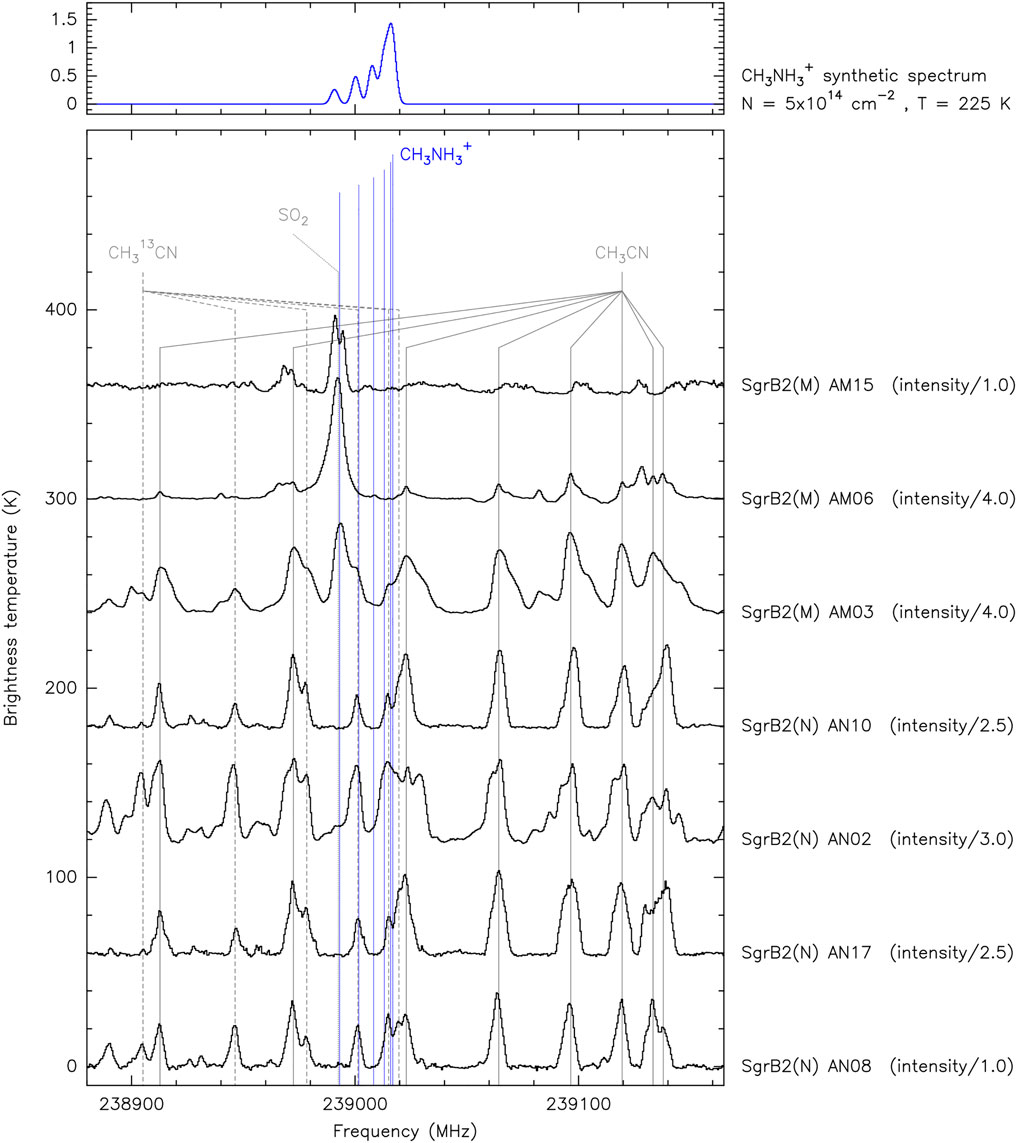
FIGURE 4. ALMA spectra towards seven dense cores in the Sgr B2(N) and (M) regions. Data from Sánchez-Monge et al. (2017). The baseline for each spectrum corresponds to a brightness temperature of 0 K, however, the spectrum of each source has been manually shifted by 60 K (with respect to the source below) for an easier visualization of the data. The intensities of some spectra have been divided by the factor indicated to the right. Grey solid and dashed vertical lines mark the transitions of CH3CN (JK = 13K − 12K),
We have selected objects in different evolutionary stages and with different physical properties. Cores AN02, AN17 and AM03 correspond to dense cores dominated by dust but with a rich chemistry. In particular, core AN02 has been extensively studied in the literature in the search of new chemical species (e.g., Belloche et al., 2014). We have also included objects in which an embedded Hii region has been found (e.g., AN10, AM06, AM15). The presence of the UV radiation from embedded massive stars ionizing the gas and resulting in Hii regions can enhance the protonation of methylamine in the photon-dominated region around the Hii region. As shown in Figure 4, no obvious features are detected at the frequencies of the tabulated
6 Conclusion and Outlook
In the present study, the pure rotational spectrum of protonated methyl amine,
Future work towards the spectroscopic characterization of protonated amines offers many possibilities, not only in the millimeter-wave regime. For example, the low-resolution vibrational spectra of
Data Availability Statement
The raw data supporting the conclusion of this article will be made available by the authors, without undue reservation.
Author Contributions
PS: measurement, manuscript writing MT: measurement ST: quantum chemical computations, data evaluation, manuscript writing CE: data evaluation, manuscript writing AS-M: data evaluation, manuscript writing AS: data evaluation, manuscript writing PS: supervision SS: supervision, manuscript writing OA: measurement, data evaluation, manuscript writing, supervision.
Funding
This work has been supported via Collaborative Research Centre 956, sub-projects A6 and B2, funded by the Deutsche Forschungsgemeinschaft (DFG, project ID 184 018 867), as well as DFG SCHL 341/15-1 (Gerätezentrum “Cologne Center for Terahertz Spectroscopy”).
Conflict of Interest
The authors declare that the research was conducted in the absence of any commercial or financial relationships that could be construed as a potential conflict of interest.
Publisher’s Note
All claims expressed in this article are solely those of the authors and do not necessarily represent those of their affiliated organizations, or those of the publisher, the editors and the reviewers. Any product that may be evaluated in this article, or claim that may be made by its manufacturer, is not guaranteed or endorsed by the publisher.
Acknowledgments
The authors gratefully acknowledge the work done over the last years by the electrical and mechanical workshops of the I. Physikalisches Institut. We thank Frank Lewen for assistance using the mm-wave setup. CE is grateful for support from the Max Planck Society.
Supplementary Material
The Supplementary Material for this article can be found online at: https://www.frontiersin.org/articles/10.3389/fspas.2021.805162/full#supplementary-material
References
Asvany, O., Bielau, F., Moratschke, D., Krause, J., and Schlemmer, S. (2010). Note: New Design of a Cryogenic Linear Radio Frequency Multipole Trap. Rev. Sci. Instrum. 81, 076102. doi:10.1063/1.3460265
Asvany, O., Brünken, S., Kluge, L., and Schlemmer, S. (2014). COLTRAP: A 22-pole Ion Trapping Machine for Spectroscopy at 4 K. Appl. Phys. B 114, 203–211. doi:10.1007/s00340-013-5684-y
Asvany, O., Krieg, J., and Schlemmer, S. (2012). Frequency Comb Assisted Mid-Infrared Spectroscopy of Cold Molecular Ions. Rev. Sci. Instrum. 83, 093110. doi:10.1063/1.4753930
Asvany, O., Markus, C. R., Roucou, A., Schlemmer, S., Thorwirth, S., and Lauzin, C. (2021). The Fundamental Rotational Transition of NO+. J. Mol. Spectrosc. 378, 111447. doi:10.1016/j.jms.2021.111447
Asvany, O., Yamada, K. M. T., Brünken, S., Potapov, A., and Schlemmer, S. (2015). Experimental Ground-State Combination Differences of CH5+. Science 347, 1346–1349. doi:10.1126/science.aaa3304
Belloche, A., Garrod, R. T., Müller, H. S. P., and Menten, K. M. (2014). Detection of a Branched Alkyl Molecule in the Interstellar Medium: Iso-Propyl Cyanide. Science 345, 1584–1587. doi:10.1126/science.1256678
Belloche, A., Müller, H. S. P., Menten, K. M., Schilke, P., and Comito, C. (2013). Complex Organic Molecules in the Interstellar Medium: IRAM 30 m Line Survey of Sagittarius B2(N) and (M). Astron. Astrophys. 559, A47. doi:10.1051/0004-6361/201321096
Borvayeh, L., Moazzen-Ahmadi, N., and Horneman, V.-M. (2008). The ν12 − ν9 Band of Ethane: A Global Frequency Analysis of Data from the Four Lowest Vibrational States. J. Mol. Spectrosc. 250, 51–56. doi:10.1016/j.jms.2008.04.009
Brünken, S., Kluge, L., Stoffels, A., Asvany, O., and Schlemmer, S. (2014). Laboratory Rotational Spectrum of l-C3H+ and Confirmation of its Astronomical Detection. Astrophys. J. Lett. 783, L4. doi:10.1088/2041-8205/783/1/l4
Brünken, S., Kluge, L., Stoffels, A., Pérez-Ríos, J., and Schlemmer, S. (2017). Rotational State-dependent Attachment of He Atoms to Cold Molecular Ions: An Action Spectroscopic Scheme for Rotational Spectroscopy. J. Mol. Spectrosc. 332, 67–78. doi:10.1016/j.jms.2016.10.018
Buhl, D., and Snyder, L. E. (1970). Unidentified Interstellar Microwave Line. Nature 228, 267–269. doi:10.1038/228267a0
Doménech, J. L., Jusko, P., Schlemmer, S., and Asvany, O. (2018a). The First Laboratory Detection of Vibration-Rotation Transitions of 12CH+ and 13CH+ and Improved Measurement of Their Rotational Transition Frequencies. Astrophys. J. 857, 61. doi:10.3847/1538-4357/aab36a
Doménech, J. L., Schlemmer, S., and Asvany, O. (2017). Accurate Frequency Determination of Vibration-Rotation and Rotational Transitions of SiH+. Astrophys. J. 849, 60. doi:10.3847/1538-4357/aa8fca
Doménech, J. L., Schlemmer, S., and Asvany, O. (2018b). Accurate Rotational Rest Frequencies for Ammonium Ion Isotopologues. Astrophys. J. 866, 158. doi:10.3847/1538-4357/aadf83
Dunning, T. H. (1989). Gaussian Basis Sets for Use in Correlated Molecular Calculations. I. The Atoms Boron through Neon and Hydrogen. J. Chem. Phys. 90, 1007–1023. doi:10.1063/1.456153
ALMA Partnership Fomalont, E. B., Vlahakis, C., Corder, S., Remijan, A., Barkats, D., et al. (2015). The 2014 ALMA Long Baseline Campaign: An Overview. Astrophys. J. Lett. 808, L1. doi:10.1088/2041-8205/808/1/L1
Fourikis, N., Takagi, K., and Morimoto, M. (1974). Detection of Interstellar Methylamine by its 202 → 110Aa-State Transition. Astrophys. J. Lett. 191, L139. doi:10.1086/181570
Gauss, J., and Stanton, J. F. (1997). Analytic CCSD(T) Second Derivatives. Chem. Phys. Lett. 276, 70–77. doi:10.1016/s0009-2614(97)88036-0
Godfrey, P. D., Brown, R. D., Robinson, B. J., and Sinclair, M. W. (1973). Discovery of Interstellar Methanimine (Formaldimine). Astrophys. Lett. 13, 119.
Herbst, E. (1985). The Rate of the Radiative Association Reaction between CH3+ and NH3 and its Implications for Interstellar Chemistry. Astrophys. J. 292, 484–486. doi:10.1086/163179
Ilyushin, V., and Lovas, F. J. (2007). Microwave Spectra of Molecules of Astrophysical Interest. Xxv. Methylamine. J. Phys. Chem. Ref. Data 36, 1141–1276. doi:10.1063/1.2769382
Jusko, P., Brünken, S., Asvany, O., Thorwirth, S., Stoffels, A., van der Meer, L., et al. (2019). The FELion Cryogenic Ion Trap Beam Line at the FELIX Free-Electron Laser Laboratory: Infrared Signatures of Primary Alcohol Cations. Faraday Discuss. 217, 172–202. doi:10.1039/c8fd00225h
Jusko, P., Stoffels, A., Thorwirth, S., Brünken, S., Schlemmer, S., and Asvany, O. (2017). High-resolution Vibrational and Rotational Spectroscopy of CD2H+ in a Cryogenic Ion Trap. J. Mol. Spectrosc. 332, 59–66. doi:10.1016/j.jms.2016.10.017
Kaifu, N., Morimoto, M., Nagane, K., Akabane, K., Iguchi, T., and Takagi, K. (1974). Detection of Interstellar Methylamine. Astrophys. J. Lett. 191, L135–L137. doi:10.1086/181569
Markus, C. R., Thorwirth, S., Asvany, O., and Schlemmer, S. (2019). High-Resolution Double Resonance Action Spectroscopy in Ion Traps: Vibrational and Rotational Fingerprints of CH2NH2+. Phys. Chem. Chem. Phys. 21, 26406–26412. doi:10.1039/c9cp05487a
Martinez, O., Lattanzi, V., Thorwirth, S., and McCarthy, M. C. (2013). Detection of Protonated Vinyl Cyanide, CH2CHCNH+, a Prototypical Branched Nitrile Cation. J. Chem. Phys. 138, 094316. doi:10.1063/1.4793316
Matthews, D. A., Cheng, L., Harding, M. E., Lipparini, F., Stopkowicz, S., Jagau, T.-C., et al. (2020). Coupled-Cluster Techniques for Computational Chemistry: The CFOUR Program Package. J. Chem. Phys. 152, 214108. doi:10.1063/5.0004837
McKellar, A. (1940). Evidence for the Molecular Origin of Some Hitherto Unidentified Interstellar Lines. Publ. Astron. Soc. Pac. 52, 187. doi:10.1086/125159
Michi, T., Ohashi, K., Inokuchi, Y., Nishi, N., and Sekiya, H. (2003). Infrared Spectra and Structures of (CH3NH2)nH+ (n = 1-4). Binding Features of an Excess Proton. Chem. Phys. Lett. 371, 111–117. doi:10.1016/s0009-2614(03)00217-3
Motiyenko, R. A., Ilyushin, V. V., Drouin, B. J., Yu, S., and Margulès, L. (2014). Rotational Spectroscopy of Methylamine up to 2.6 THz. Astron. Astrophys. 563, A137. doi:10.1051/0004-6361/201323190
Ohashi, N., Takagi, K., Hougen, J. T., Olson, W. B., and Lafferty, W. J. (1987). Far-Infrared Spectrum and Ground State Constants of Methyl Amine. J. Mol. Spectrosc. 126, 443–459. doi:10.1016/0022-2852(87)90249-9
Ozier, I., and Moazzen-Ahmadi, N. (2007). “Internal Rotation in Symmetric Tops,” in Advances in Atomic, Molecular, and Optical Physics. Editors P. R. Berman, C. C. Lin, and E. Arimondo (Amsterdam: Elsevier), 54, 423–509. doi:10.1016/s1049-250x(06)54007-8
Pelz, G., Mittler, P., Yamada, K. M. T., and Winnewisser, G. (1992). Millimeter-Wave Spectra and Revised Spectroscopic Parameters of Methylsilane. J. Mol. Spectrosc. 156, 390–402. doi:10.1016/0022-2852(92)90240-o
Peterson, K. A., and Dunning, T. H. (2002). Accurate Correlation Consistent Basis Sets for Molecular Core-Valence Correlation Effects: The Second Row Atoms Al-Ar, and the First Row Atoms B-Ne Revisited. J. Chem. Phys. 117, 10548–10560. doi:10.1063/1.1520138
Puzzarini, C., Stanton, J. F., and Gauss, J. (2010). Quantum-Chemical Calculation of Spectroscopic Parameters for Rotational Spectroscopy. Int. Rev. Phys. Chem. 29, 273–367. doi:10.1080/01442351003643401
Raghavachari, K., Trucks, G. W., Pople, J. A., and Head-Gordon, M. (1989). A Fifth-Order Perturbation Comparison of Electron Correlation Theories. Chem. Phys. Lett. 157, 479–483. doi:10.1016/s0009-2614(89)87395-6
Sánchez-Monge, Á., Schilke, P., Schmiedeke, A., Ginsburg, A., Cesaroni, R., Lis, D. C., et al. (2017). The Physical and Chemical Structure of Sagittarius B2. II. Continuum Millimeter Emission of Sgr B2(M) and Sgr B2(N) with ALMA. Astron. Astrophys. 604, A6. doi:10.1051/0004-6361/201730426
Schilke, P., Walmsley, C. M., Millar, T. J., and Henkel, C. (1991). Protonated HCN in Molecular Clouds. Astron. Astrophys. 247, 487.
Schmiedeke, A., Schilke, P., Möller, T., Sánchez-Monge, Á., Bergin, E., Comito, C., et al. (2016). The Physical and Chemical Structure of Sagittarius B2. I. Three-Dimensional Thermal Dust and Free-Free Continuum Modeling on 100 au to 45 pc Scales. Astron. Astrophys. 588, A143. doi:10.1051/0004-6361/201527311
Schwörer, A., Sánchez-Monge, Á., Schilke, P., Möller, T., Ginsburg, A., Meng, F., et al. (2019). The Physical and Chemical Structure of Sagittarius B2. IV. Converging Filaments in the High-Mass Cluster Forming Region Sgr B2(N). Astron. Astrophys. 628, A6. doi:10.1051/0004-6361/201935200
Snyder, L. E., and Buhl, D. (1972). Detection of Several New Interstellar Molecules. Ann. N. Y. Acad. Sci. 194, 17–24. doi:10.1111/j.1749-6632.1972.tb12687.x
Snyder, L. E., and Buhl, D. (1971). Observations of Radio Emission from Interstellar Hydrogen Cyanide. Astrophys. J. Lett. 163, L47. doi:10.1086/180664
Stanton, J. F., and Gauss, J. (2000). Analytic Second Derivatives in High-Order many-body Perturbation and Coupled-Cluster Theories: Computational Considerations and Applications. Int. Rev. Phys. Chem. 19, 61–95. doi:10.1080/014423500229864
Stanton, J. F., Lopreore, C. L., and Gauss, J. (1998). The Equilibrium Structure and Fundamental Vibrational Frequencies of Dioxirane. J. Chem. Phys. 108, 7190–7196. doi:10.1063/1.476136
Thaddeus, P., Guélin, M., and Linke, R. A. (1981). Three New 'nonterrestrial' Molecules. Astrophys. J. 246, L41–L45. doi:10.1086/183549
Thorwirth, S., Schreier, P., Salomon, T., Schlemmer, S., and Asvany, O. (2019a). Pure Rotational Spectrum of CN+. Astrophys. J. Lett. 882, L6. doi:10.3847/2041-8213/ab3927
Thorwirth, S., Schmid, P. C., Töpfer, M., Brünken, S., Asvany, O., and Schlemmer, S. (2019b). “Spectroscopic Studies of Protonated Amines: CH3NH3+ and C2H5NH3+,” in International Symposium on Molecular Spectroscopy, 74th meeting, Champaign-Urbana, IL, U.S.A., June 17-21, Talk WF04.
Turner, B. E. (1974). U93.174 - A New Interstellar Line with Quadrupole Hyperfine Splitting. Astrophys. J. Lett. 193, L83. doi:10.1086/181638
Wakelam, V., Loison, J. C., Herbst, E., Pavone, B., Bergeat, A., Beroff, K., et al. (2015). The 2014 KIDA Network for Interstellar Chemistry. Astrophys. J. Suppl. Ser. 217, 20. doi:10.1088/0067-0049/217/2/20
Wang, S.-X., Schroderus, J., Ozier, I., Moazzen-Ahmadi, N., McKellar, A. R. W., Ilyushyn, V. V., et al. (2001). Infrared and Millimeter-Wave Study of the Four Lowest Torsional States of CH3CF3. J. Mol. Spectrosc. 205, 146–163. doi:10.1006/jmsp.2000.8235
Watts, J. D., Gauss, J., and Bartlett, R. J. (1992). Open-Shell Analytical Energy Gradients for Triple Excitation many-body, Coupled-Cluster Methods: MBPT(4), CCSD+T(CCSD), CCSD(T), and QCISD(T). Chem. Phys. Lett. 200, 1–7. doi:10.1016/0009-2614(92)87036-o
Western, C. M. (2017). Pgopher: A Program for Simulating Rotational, Vibrational and Electronic Spectra. J. Quant. Spectrosc. Radiat. Transf. 186, 221–242. doi:10.1016/j.jqsrt.2016.04.010
Zeroka, D., and Jensen, J. O. (1998). Infrared Spectra of Some Isotopomers of Methylamine and the Methylammonium Ion: A Theoretical Study. J. Mol. Struct. THEOCHEM 425, 181–192. doi:10.1016/s0166-1280(97)00109-7
Ziurys, L. M., and Turner, B. E. (1986). HCNH(+) - A New Interstellar Molecular Ion. Astrophys. J. 302, L31–L36. doi:10.1086/184631
Keywords: rotational spectroscopy, protonated methylamine, ion trap, astrochemistry, symmetric top molecule
Citation: Schmid PC, Thorwirth S, Endres CP, Töpfer M, Sánchez-Monge Á, Schwörer A, Schilke P, Schlemmer S and Asvany O (2022) Rotational Rest Frequencies and First Astronomical Search of Protonated Methylamine. Front. Astron. Space Sci. 8:805162. doi: 10.3389/fspas.2021.805162
Received: 29 October 2021; Accepted: 22 December 2021;
Published: 02 February 2022.
Edited by:
André Canosa, UMR6251 Institut de Physique de Rennes (IPR), FranceReviewed by:
Roman Motiyenko, Université de Lille, FranceAnthony Remijan, National Radio Astronomy Observatory, United States
Copyright © 2022 Schmid, Thorwirth, Endres, Töpfer, Sánchez-Monge, Schwörer, Schilke, Schlemmer and Asvany. This is an open-access article distributed under the terms of the Creative Commons Attribution License (CC BY). The use, distribution or reproduction in other forums is permitted, provided the original author(s) and the copyright owner(s) are credited and that the original publication in this journal is cited, in accordance with accepted academic practice. No use, distribution or reproduction is permitted which does not comply with these terms.
*Correspondence: Oskar Asvany, asvany@ph1.uni-koeln.de
†Present Address: Matthias Töpfer, Vinnolit GmbH & Co. KG, Hürth, Germany
 Philipp C. Schmid1
Philipp C. Schmid1  Sven Thorwirth
Sven Thorwirth Stephan Schlemmer
Stephan Schlemmer Oskar Asvany
Oskar Asvany